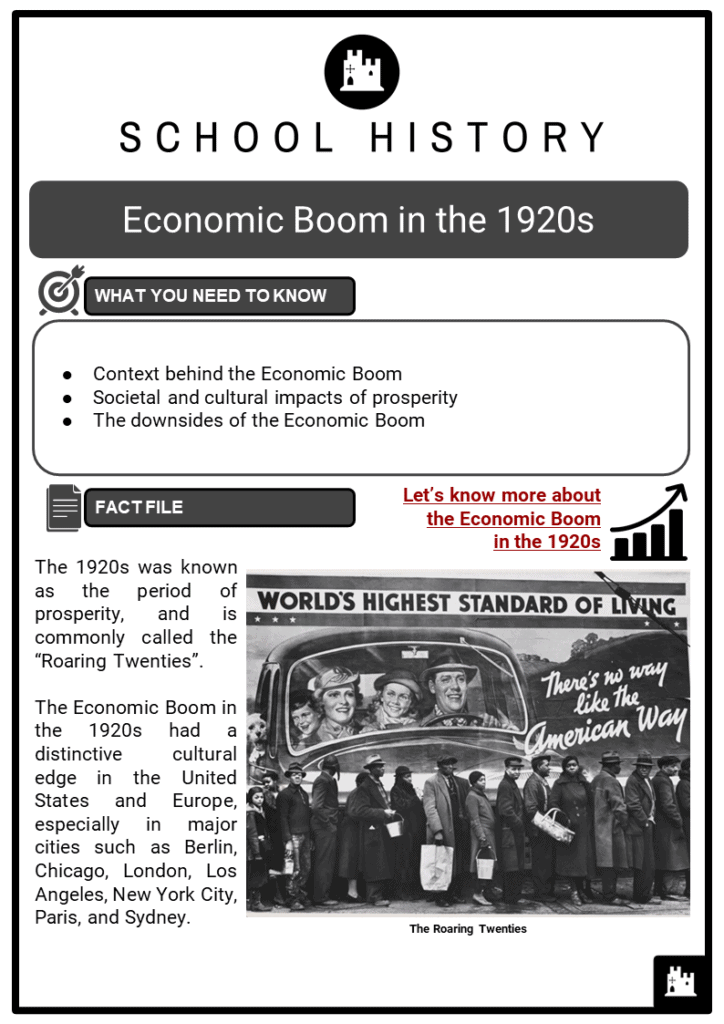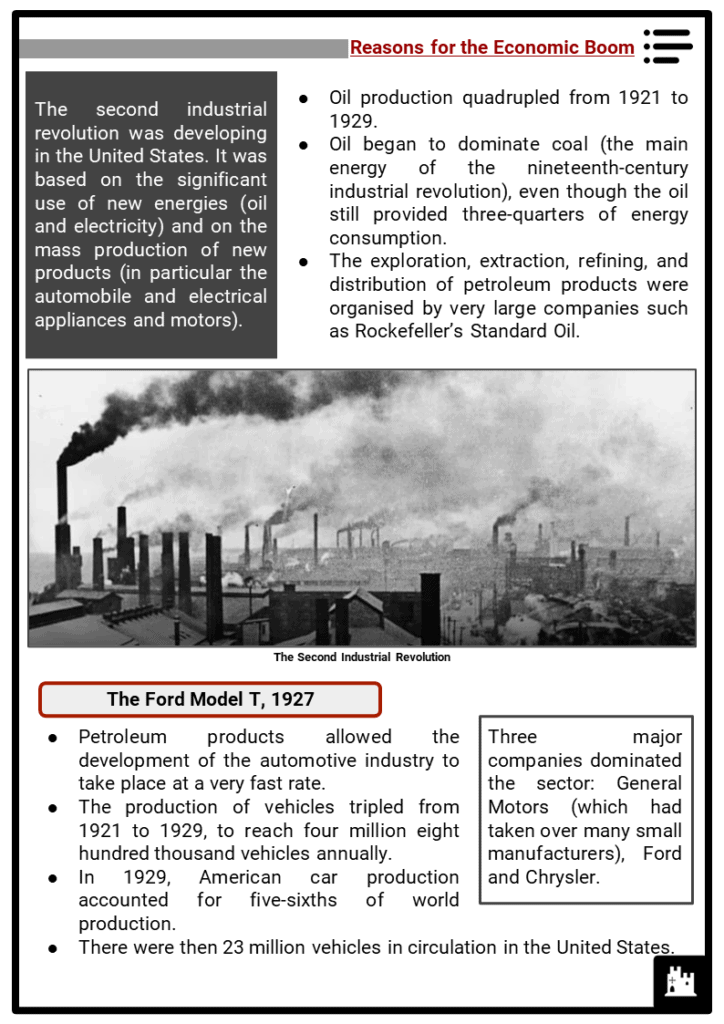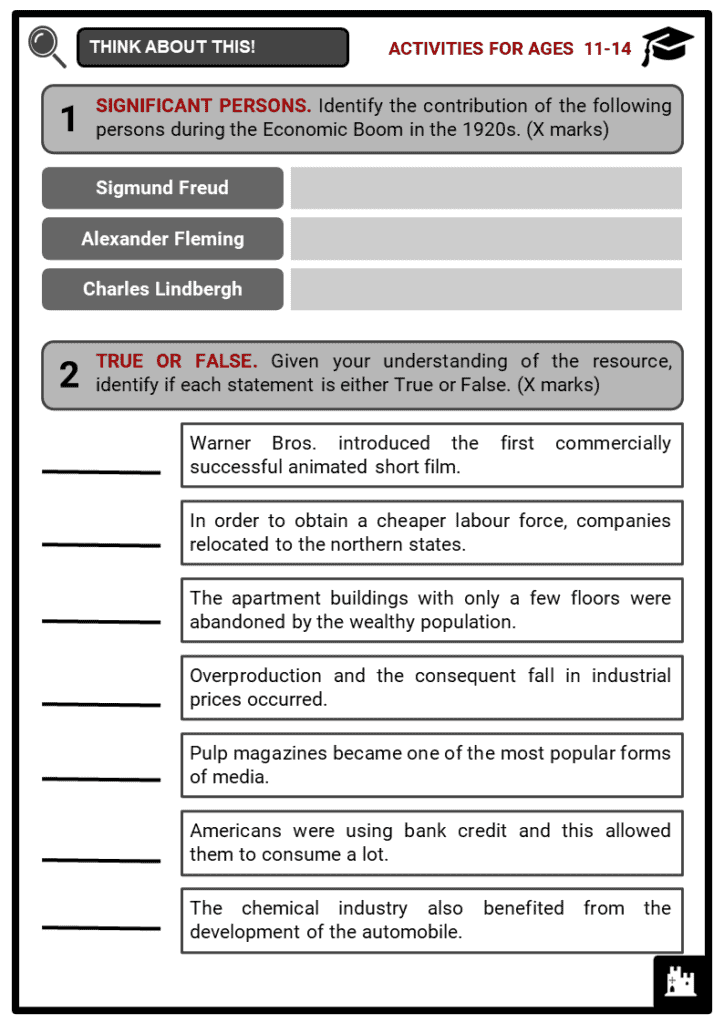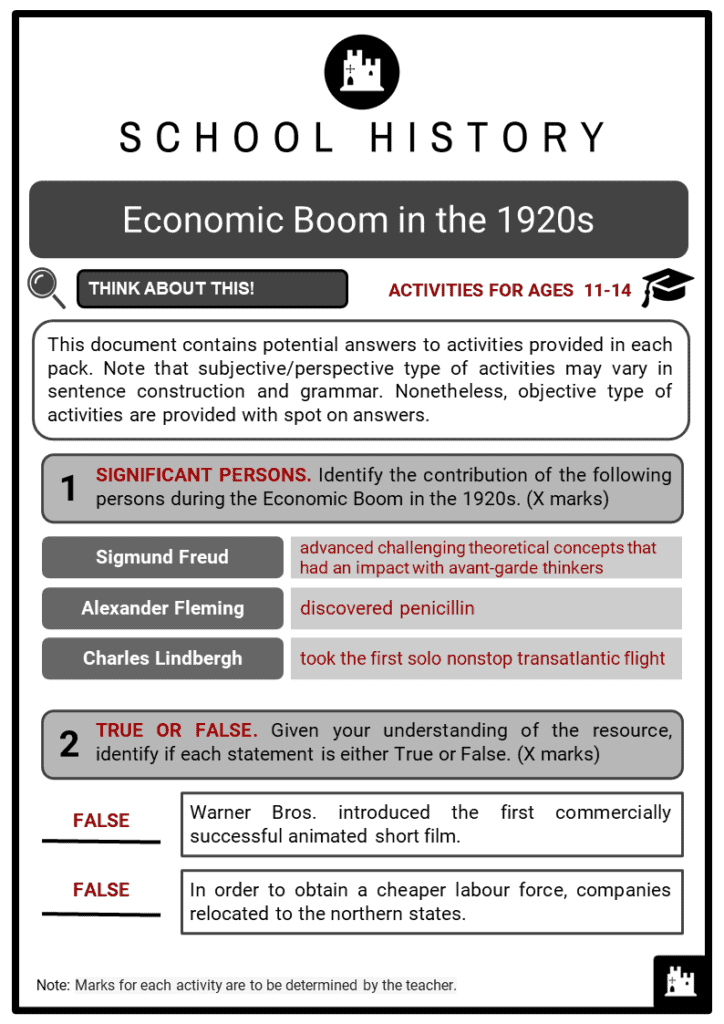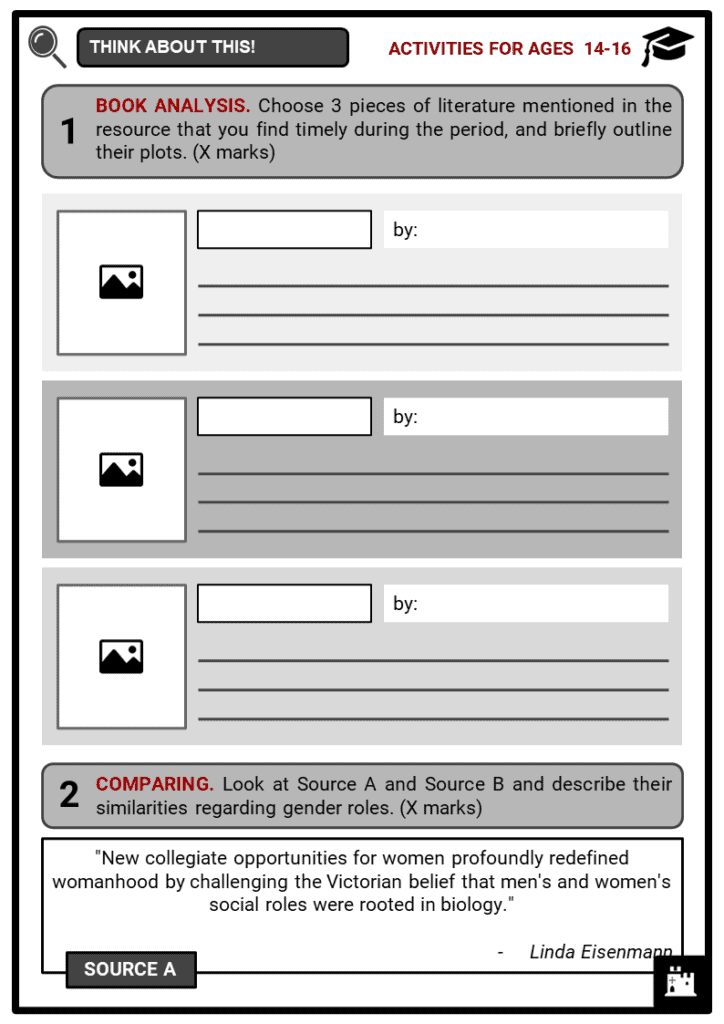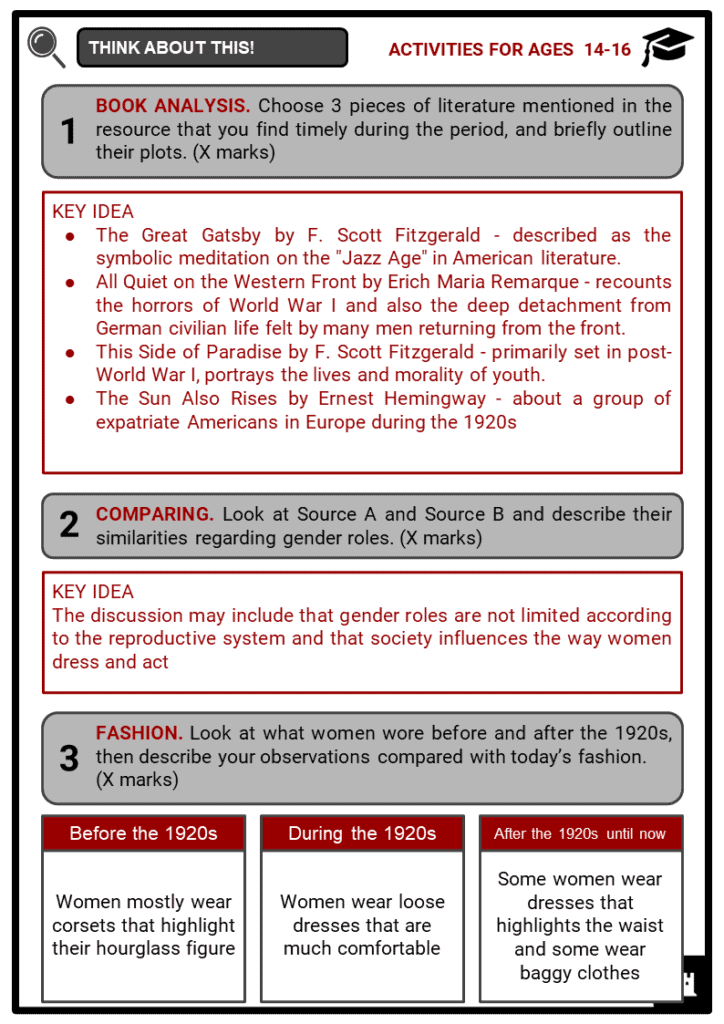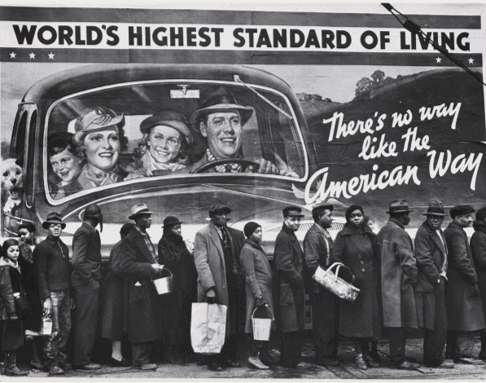Download Economic Boom in the 1920s Worksheets
Do you want to save dozens of hours in time? Get your evenings and weekends back? Be able to teach Economic Boom in the 1920s to your students?
Our worksheet bundle includes a fact file and printable worksheets and student activities. Perfect for both the classroom and homeschooling!
Table of Contents
Add a header to begin generating the table of contents
Summary
- Context behind the Economic Boom
- Societal and cultural impacts of prosperity
- The downsides of the Economic Boom
Key Facts And Information
Let’s know more about the Economic Boom in the 1920s
- The 1920s was known as the period of prosperity, and is commonly called the “Roaring Twenties”.
- The Economic Boom in the 1920s had a distinctive cultural edge in the United States and Europe, especially in major cities such as Berlin, Chicago, London, Los Angeles, New York City, Paris, and Sydney.
Reasons for the Economic Boom
- The second industrial revolution was developing in the United States. It was based on the significant use of new energies (oil and electricity) and on the mass production of new products (in particular the automobile and electrical appliances and motors).
- Oil production quadrupled from 1921 to 1929.
- Oil began to dominate coal (the main energy of the nineteenth-century industrial revolution), even though the oil still provided three-quarters of energy consumption.
- The exploration, extraction, refining, and distribution of petroleum products were organised by very large companies such as Rockefeller’s Standard Oil.
- Petroleum products allowed the development of the automotive industry to take place at a very fast rate.
- The production of vehicles tripled from 1921 to 1929, to reach four million eight hundred thousand vehicles annually.
- In 1929, American car production accounted for five-sixths of world production.
- There were then 23 million vehicles in circulation in the United States.
- Three major companies dominated the sector: General Motors (which had taken over many small manufacturers), Ford and Chrysler.
- To supply the metal sheets necessary for bodywork and metal parts, steel production almost doubled between 1921 and 1929. It was also stimulated by the use of steel beams in the construction of skyscrapers, which were multiplying in American cities. The chemical industry also benefited from the development of the automobile, as it was involved in manufacturing tyres.
- The production of aluminium, which requires a large amount of electricity for its manufacture, also increased. This promoted the development of civil aviation and revolutionised US inland transport from 1926 (the first transatlantic crossing was conducted in May 1927, by Charles Lindbergh on his single-engined plane, Spirit of Saint Louis).
- Electricity consumption increased five-fold between 1921 and 1929. Factories replaced their old steam engines with electric motors (70% of the factory engines in 1929). The most affluent Americans had many electrical devices (wireless radios, telephones, vacuum cleaners, refrigerators) that improved their living conditions.
- The development of production made it possible to increase the turnover and therefore the profits of the companies.
- The shareholders who owned these companies, who received a portion of the profits each year, got richer.
- It also met the growing demand of the population.
- Growth was made possible by strong financial investment in building and equipping new factories, and also the use of new methods of work.
- The number of consumers also increased. The birth rate, although declining, remained strong. However, immigration decreased.
- After the war of 1914-1918 there was a puritanical and xenophobic reaction between 1921 and 1924.
- Laws were introduced that restricted the number of immigrants coming from Europe and South America.
- The population continued to urbanise (50% in 1920 and 56% in 1930).
- This increased urbanisation meant more people needed cars and electricity. It was therefore necessary to increase their income.
- Many bosses, following the example of Henry Ford, increased wages. But this remained insufficient and more and more Americans used bank credit to increase their consumption.
- This made them live beyond their real financial means. Republicans were in power from 1921 to March 1933. They took protectionist customs measures that reduced imports of foreign products likely to compete with US products (especially in agriculture and the chemical, textile, and metal industries).
- Financing for development was provided by the banks. They alone were now able to gather the huge capital needed.
- They installed agencies everywhere that collected American savings. Bank deposits, whose customers could withdraw their money at any time, became merchant banks lending to businesses.
- But for this reason, they immobilised this money for several years. They took a big risk in the event of massive withdrawals by savers.
- However, bank credit was abundant. The United States owned 60% of the world’s gold stock by then.
- The US dollar was convertible into gold. The dollar inspired confidence.
- Since 1922, with the Gold Exchange Standard, it had served as a reserve currency for all countries of the world.
- To increase the productivity of their employees and the profitability of the invested capital, the industrialists generalised new methods of work. Tailoring, assembly line work and standardisation made it possible to achieve these goals. In order to obtain a cheaper labour force than that of the old industrial regions of the north-east and the Great Lakes, companies relocated to the southern states. There, poor rural people could be hired at a good price. This was the beginning of the industrialisation of the south. They also wanted to get closer to new energy sources like Texas oil.
Rise of the Economy
- In the 1920s, the so-called “American Way of Life” was introduced. In 1930, 56% of the American population was urbanised. Large cities were concentrated mainly in the north-east and Great Lakes regions. Cities were expanding and changing in appearance.
- In the city centres, skyscrapers were built (with 86 floors and 400 metres high, the Empire State Building of Manhattan in New York was for a long time the tallest building in the world). The upper floors were occupied by offices and the ground floors by shops.
- The apartment buildings with only a few floors were abandoned by the wealthy population. Instead, they were occupied by a poor population formed by black people fleeing racial segregation in the southern states, and those rural people who had been uprooted by an agricultural crisis that had been growing since 1920.
Inventions and Technology
- The Ford Motor Company discontinued the production of the Ford Model T after selling 15 million units in 1927. Ford opened outlets around the world and beat the competition with its low-cost, easy-maintenance vehicles. General Motors followed and European competitors focused instead on the more expensive vehicles for wealthier customers.
- The automobile was common in the cities. Thanks to lower prices and bank credit, the car appealed to employees and workers, who represented about 60% of vehicle owners. While creating new trades, the automobile also allowed those who were better off to migrate to the suburbs, and created a new urban landscape (paved roads, road signs).
- Electricity allowed the introduction of household comfort in homes.
- The small size of the electric motor allowed it to operate vacuum cleaners, washing machines and refrigerators.
- This revolutionised housework. Electricity also allowed the development of new leisure.
- In 1925, electrical recordings became commercially available, with gramophone records. The establishment of the Federal Radio Commission in 1927 introduced a new era of regulation for radio programming.
- At the end of 1920s the introduction of sound film, also known as the talkies, eliminated vaudeville entertainment.
- The first commercially successful animated short film was introduced by the Walt Disney Animation Studios, and starred Mickey Mouse.
- Charles Lindbergh took the first solo nonstop transatlantic flight in 1927 with the Spirit of St. Louis, his aircraft, which was a custom-built, single-engine, and single-seat monoplane.
- In 1928, Alexander Fleming discovered penicillin, a substance that kills a number of disease-causing bacteria.
Other Impacts
- The thirst for consumption promoted economic development but also lead to a huge waste of materials and space. Americans, at least those who had the financial means, preferred to buy something new rather than to repair broken items.
- Women gained their material independence through wage labour. More were liberalised, new ways of dressing and living were adopted. However, these changes did not shake a part of the population who remained attached to traditional practices. The woman was considered to be the guardian of the home and the pole of stability in the family.
- Women were given the right to vote and to be more independent by having careers in offices and schools. During World War I, women were allowed to work in various industries, including chemical, automobile, iron and steel manufacturing. Women’s desire for freedom and independence also influenced fashion. The hourglass figure was set aside and the boyish style became popular.
- Homosexuality was also given more attention during that period, especially in London, New York, Paris, Rome, and Berlin. Homosexuals were known as the effeminate “third sex” in which their sexual ambiguity and nonconformity was biologically determined, according to the Scientific-Humanitarian Committee. Humour was used to slowly accept homosexual people.
- The 1920s was also a period of literary creativity and the works of some authors became popular during the period. Some of these include: The Great Gatsby by F. Scott Fitzgerald, All Quiet on the Western Front by Erich Maria Remarque, This Side of Paradise by F. Scott Fitzgerald, and The Sun Also Rises by Ernest Hemingway.
- Pulp magazines became one of the most popular forms of media during the 1920s as they provided affordable entertainment.
- Austrian neurologist Sigmund Freud played a major role in Psychoanalysis. He advanced challenging theoretical concepts that had an impact with avant-garde thinkers, particularly in the humanities and artistic fields.
Excluded from Prosperity
- Agriculture
- From 1925, American farmers were in trouble.
- They had gone into debt to modernise their farms during the First World War, in order to supply France and the United Kingdom during the war.
- But the competition of the “new countries” and the reconstruction of European agriculture once peace returned, deprived them of customers.
- Overproduction resulted in a fall in agricultural prices. Unable to repay their bank loans, farmers sold all their equipment and land.
- At best they remained as agricultural wage earners, at worst they had to go to the cities where they hoped to find work. Those who remained did not enjoy the material benefits of the economic boom.
- Immigrants
- Recent immigrants (those who had arrived since the beginning of the century) faced hostility from the settled Americans. Territorial conquest at the expense of the Native Americans was completed. New immigrants were thus forced to stay in the cities. They were concentrated in certain neighbourhoods: there were many “Little Italies” in American cities.
- Immigrants were accused of spreading dangerous ideas like socialism and anarchism. The trial of two Italian immigrants, Sacco and Vanzetti, in 1921 and their execution in 1927 testify to the violence of this hostility.
- Immigrants were accused of taking jobs away from already established workers and of accepting low wages. Late immigrants came from Southern Europe (mostly Italians) or Eastern Europe (Russians and Poles). The “old Americans” reproached them for introducing ideas, such as Catholicism, to a society dominated by Protestantism.
- In order to “protect” white, Protestant American society, the Congress passed two waves of laws in 1921 and 1924. By quotas based on ethnic origin, they hardened the conditions of the entry of immigrants to “dry up” the arrival of Italians and Slavs, while promoting the entry of the British and Germans. Whereas before the World War I, every year nearly 680,000 Europeans from the south and east entered the United States, there were only 150,000 in 1921 and just under 22,000 in 1924.
Image sources:
- https://www.historynet.com/wp-content/uploads/2018/09/American_way_of_life.jpg
- https://upload.wikimedia.org/wikipedia/commons/thumb/1/12/1925_Ford_Model_T_touring.jpg/560px-1925_Ford_Model_T_touring.jpg
- https://upload.wikimedia.org/wikipedia/commons/thumb/a/ab/Equal_Rights_Envoys_159003v.jpg/440px-Equal_Rights_Envoys_159003v.jpg

